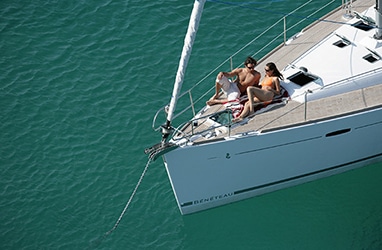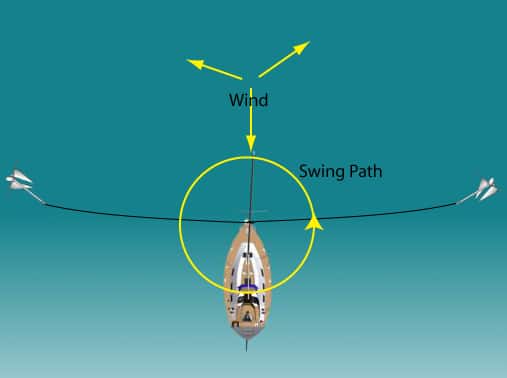
This article is an excerpt from NauticEd’s Bareboat Charter Course, a comprehensive online course that equips you with all the necessary skills and knowledge to successfully charter a yacht. The Bareboat Charter course is part of the Bareboat Charter Master bundle of online courses, fully preparing you for near-coastal sailing and sailing charters.
You can learn to sail and improve your sailing with NauticEd, the international leader in sailing education.
Anchoring with multiple anchors
Finally, regarding anchoring, we will cover:
- Multiple anchors
- Weighing Anchor
Multiple Anchors
Setting multiple anchors has multiple advantages. It reduces swing, reduces the holding load required by each anchor, and can act as a backup.
Disadvantages are: You will swing less than other boats in the same anchorage area increasing the chance of a midnight collision. You may get tangled anchor rodes if the wind clocks around. More complicated deployment and retrieval plan.

Front Anchor Deployed with Several Long Ropes to Rocks on Land
Other types of anchoring can include tying off to points on land. This is desirable if you are in a narrow cove or your swing ability is restricted. Be wary, however, that your lines ashore may not be visible to others, especially in poor light conditions. We tie dock fenders at strategically visible points along the shoreline. While jet skis can be annoying sometimes to sailors a strangled one just creates complications that we don’t want to encounter with the authorities.
Personally, I don’t particularly like a stern anchor. If the wind turns 90 degrees then extra windage force is placed on both anchors potentially causing both of them to drag.

The best multiple anchor techniques are the 45-degree method and the 180-degree method (aka Bahamian anchoring). 45-degree anchoring means that you set two anchors from the bow so that when the anchoring process is complete, they are angled approximately 45 degrees apart. This method is best for holding in strong winds.
Similarly, in the Bahamian anchor method, the anchors are 180 degrees apart. With this method, your swing will be minimized.

Weighing the Anchor (Retrieving the Anchor)
Simple enough – motor the boat forward while pulling in the anchor rode right? Yes – except there can be complications and considerations.
Using a windlass:
First, in high winds, make sure that you do not use the windlass to pull the boat forward against the wind, instead motor the boat forward. Otherwise, you’ll over-tension the windlass, blow the breaker switch, and potentially damage the windlass. In light wind conditions, you can operate the windlass for a few seconds. The weight of the rode will then act to pull the boat forward reducing the tension. Then repeat. In this manner, the boat starts moving forward purely from the weight of the anchor rode.
Doing it by hand:
Similarly as above use the motor, or in lighter winds, allow the weight of the anchor rode to do the work of moving the boat forward for you.
Unfortunately, you will at times get the anchor stuck on something. If you know you’re going to be anchoring in rocks then a good idea is to send down a trigger line as you deploy the anchor. A trigger line is a line attached to the head of the anchor. It can be used to pull the anchor out backwards by its head. But it requires forethought.
So – here are your retrieval plans.
Plan A: As the vessel moves over the spot where the anchor is – pull it up – if you can. Stop the vessel’s forward motion – as you continue pulling in the anchor. If you use an electric windlass to raise the anchor, be sure not to overstrain it by using it to pull the boat towards the anchor. Allow the engine to do that work.

Plan B: If the anchor is set hard and you cannot pull it in, you may need to use the vessel’s forward motion to break the anchor loose. This means maintaining a slight forward motion and cleating the rode as you pass over the spot. The theory is that the vessel’s momentum will break loose the anchor. Be VERY wary of the strength of the cleat on your boat.
Plan C: If the anchor fails to break loose, due to rock formation, you can try pulling it out backwards by motoring to windward. The flatter the angle you pull the anchor out, the greater the chance of retrieval, so let out lots of rode when motoring to windward. Be conscious of the rode and propeller at all times.
Plan D: Try pulling the anchor out sideways. Let out lots of rode and motor
Plan E: Persistence and various combinations of the above will normally enable you to retrieve your anchor
Plan F: See Plan E
Tip: If you don’t have a windlass and you’re feeling a little tired; you can run the rode back to one of the winches atop the cabin.
|
Anecdote BTW- we were visiting a very cool place. It was a cave where the entrance was under the water. The light shining through the underwater entrance and up into the cave was spectacular.
Cool eh?
|
Watch out that you’re not stuck on a boat dock cable from a marina. In lakes, often you might be stuck on an old stump.
The very worst scenario is that you will have to leave the anchor and rode for later recovery with a professional. In this case, don’t cut it but tie a floating bottle to the rode end. Tie a note in a plastic bag to tell others that you’re coming back for it and to please not help themselves. You can cut the rode and just get another one, however, keep in mind that anchors with rode are not cheap; they range from $300 USD and up. This helps underscore the need to carry an extra anchor and rode for just such an unfortunate occasion. If the rode is all chain, the cost can be over $1000 USD to replace.
OK so that’s a pretty comprehensive section on anchoring, but as stated on a yacht charter you do spend a lot of time at anchor so knowing all the above is well worthwhile.
Click the like button here if you liked the anchoring section of this clinic … please! Your Facebook friends will see a note on your wall that you liked it. Cheers for that.
You can learn more in the Bareboat Charter Online Course....
The Bareboat Charter online sailing course is your go-to resource for planning an unforgettable sailing vacation. This comprehensive online course equips you with all the necessary skills and knowledge to successfully charter a yacht. Upgrade to the Bareboat Charter Master bundle of courses to fully prepare for near-coastal sailing and sailing charters.

